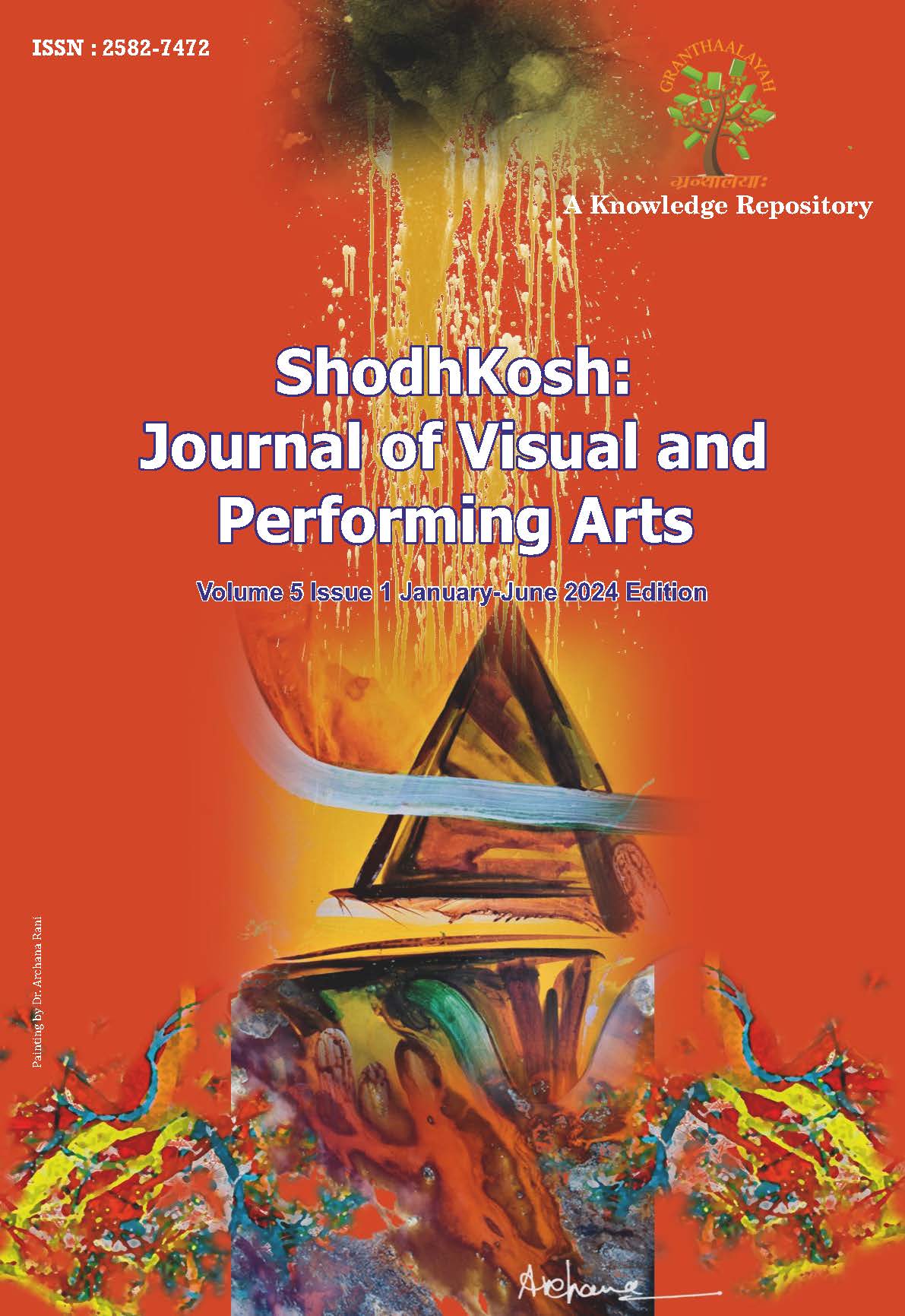AN ANALYTICAL STUDY OF PATINA RECIPES WITH REFERENCE TO BRASS METAL SCULPTURES
DOI:
https://doi.org/10.29121/shodhkosh.v5.i1.2024.874Keywords:
Patina, Patination, Surface Treatment, Chemical Compositions, Protective Covering, Coastal/Marine Environments, Brass Alloy, Copper and Zinc, Ferric Oxide, Tin Oxide, Sulphate CompoundsAbstract [English]
This paper attempts to explore the new patina recipes for brass metal sculptures. It is based on experiments on new patina recipes with the help of the required percentage of chemical compositions and exploring the new way of surface treatment of brass metal sculptures in the form of texture and polish through a chemical process. This research delves into the development and characterization of innovative brass patina recipes aimed at achieving both enhanced aesthetics and improved durability. Brass, an alloy of copper and zinc, has a long history of artistic and practical applications due to its malleability, color, and corrosion resistance. The patina, a surface layer formed over time, adds distinct visual appeal and protective qualities to brass objects. Traditional patina recipes often rely on the interaction of copper with atmospheric elements, leading to variable and unpredictable results. In this study, a systematic approach was undertaken to formulate new brass patina recipes using controlled chemical reactions. By experimenting with various compounds, solutions, and application techniques, a range of patina colors and textures were achieved. Corrosion resistance testing was conducted to comprehensively characterize the developed patinas in terms of their composition, microstructure, and protective properties. The results of this research highlight the potential for customizing brass patina recipes to cater to specific artistic and functional requirements. The newly developed recipes offer consistent and controllable outcomes, reducing the reliance on unpredictable natural processes. The improved understanding of the patina's chemical composition i.e. Ferric oxide, Tin oxide, sulphate compounds etc. and structural attributes contribute to the preservation and maintenance of brass objects over time. This research not only advances the field of material science by presenting novel approaches to brass patination but also provides artisans, conservators, and manufacturers with valuable insights into creating visually appealing brass objects with enhanced durability in coastal/marine environments. The findings open avenues for further investigation into the broader applications of controlled patina formation on other metal alloys and contribute to the sustainable use and appreciation of brass Sculptures.
References
Experiments conducted in Studio/open air at Department of Sculpture, The M.S. University of Baroda,vadodara 2016-2017.
Observations made in Studio/open air at Department of Sculpture, The M.S. University of Baroda,vadodara 2016-2017.
Richard Hughes, Michael Rowe (1991) - The Colouring, Bronzing and Patination of Metals. London: Thames & Hudson Ltd. ISBN 0-500-01501-5. https://thamesandhudson.com/colouring-bronzing-and-patination-of-metals-a-manual-for-fine-metalworkers-sculptors-9780500015018
¬¬¬¬¬¬¬¬¬¬¬¬¬¬¬¬¬¬¬¬¬¬¬¬ Luc Robbiola, Richard Portier (2006) Journal of Cultural Heritage, Volume 7, Issue 1, Pages 1-12. https://www.sciencedirect.com/science/article/abs/pii/S1296207405001147
Dr S.Marichamy, M. Saravanan, Manickam Ravichandran, Stalin Balasubramaniam (2017) Mechanics and Mechanical Engineering, Optimization of Surface Roughness for Duplex Brass Alloy in EDM Using Response Surface Methodology, Vol. 21, No. 1 57–66. https://www.researchgate.net/publication/319482022
Melania Di Fazio , Anna Candida Felici , Fiorenzo Catalli , María Teresa Doménech-Carbó , Caterina De Vito, Antonio Doménech-Carbó (2020) Microchemical Journal, Volume 152, 104306. https://www.sciencedirect.com/science/article/abs/pii/S0026265X1932483X#preview-section-recommended-articles DOI: https://doi.org/10.1016/j.microc.2019.104306
Philippe Colomban, Aurélie Tournié, Michel Maucuer, Philippe Meynard (2011) On-site Raman and XRF analysis of Japanese/Chinese bronze/brass patina. https://analyticalsciencejournals.onlinelibrary.wiley.com/doi/full/10.1002/jrs.3095 DOI: https://doi.org/10.1002/jrs.3095
Egyptian Journal of Archaeological and Restoration Studies (2014) "Ejars" a scientific study of the patina, corrosion morphology, and conservation of egyptian brass object, An International peer-reviewed journal published bi-annually Volume 4, Issue 1, pp: 25-33, www. ejars.sohag-univ.edu.eg DOI: https://doi.org/10.21608/ejars.2018.7271
Mohamed Moatamed Megahed; Mohamed Youssif; Ashraf M El-Shamy (2020) Selective Formula as A Corrosion Inhibitor to Protect the Surfaces of Antiquities Made of Leather-Composite Brass Alloy, Egyptian Journal of Chemistry, Article 49, Volume 63, Issue 12, Page 5269-5287. https://journals.ekb.eg/article_113697.html
A. Zh. Zhomartova, E. F. Shaykhutdinova, B. A. Bakirov, S. E. Kichanov, D. P. Kozlenko, A. G. Sitdikov (2022) Structural studies of the brass ingots from the Shcherbet historical complex of the Lower Kama region: neutron diffraction and tomography studies, Vol 6, No. 3 . https://doi.org/10.32523/ejpfm.2022060303 DOI: https://doi.org/10.32523/ejpfm.2022060303
Hannes W. Vereecke, Bernadette Frühmann, and Manfred Schreiner (2012)The Chemical Composition of Brass in Nuremberg Trombones of the Sixteenth Century, Page 61 Brass Soc. J. https://www.researchgate.net/profile/Hannes-Vereecke/publication/237047737 DOI: https://doi.org/10.2153/0120120011004
S. Goidanich, J. Brunk, G. Herting, M.A. Arenas, I. Odnevall Wallinder (2011) Science of The Total Environment, Atmospheric corrosion of brass in outdoor applications: Patina evolution, metal release and aesthetic appearance at urban exposure conditions, Volumes 412–413, 15, Pages 46-57. https://www.sciencedirect.com/science/article/abs/pii/S004896971101117X DOI: https://doi.org/10.1016/j.scitotenv.2011.09.083
Einar Mattsson (2013) Corrosion of Copper and Brass: Practical Experience in relation to Basic Data, Pages 6-13 | Published online. https://www.tandfonline.com/doi/abs/10.1179/000705980798318708 DOI: https://doi.org/10.1179/000705980798318708
Julie Jerman-Melka (1996) Patination with non-toxic solutions, Department of Visual Art Colorado State University Fort Collins, Colorado Fall. https://api.mountainscholar.org/server/api/core/bitstreams/b22f1600-a7cb-43f0-94fb-8133b0f52b45/content
Downloads
Published
How to Cite
Issue
Section
License
Copyright (c) 2024 Ajay Kumar Kanwal

This work is licensed under a Creative Commons Attribution 4.0 International License.
With the licence CC-BY, authors retain the copyright, allowing anyone to download, reuse, re-print, modify, distribute, and/or copy their contribution. The work must be properly attributed to its author.
It is not necessary to ask for further permission from the author or journal board.
This journal provides immediate open access to its content on the principle that making research freely available to the public supports a greater global exchange of knowledge.































